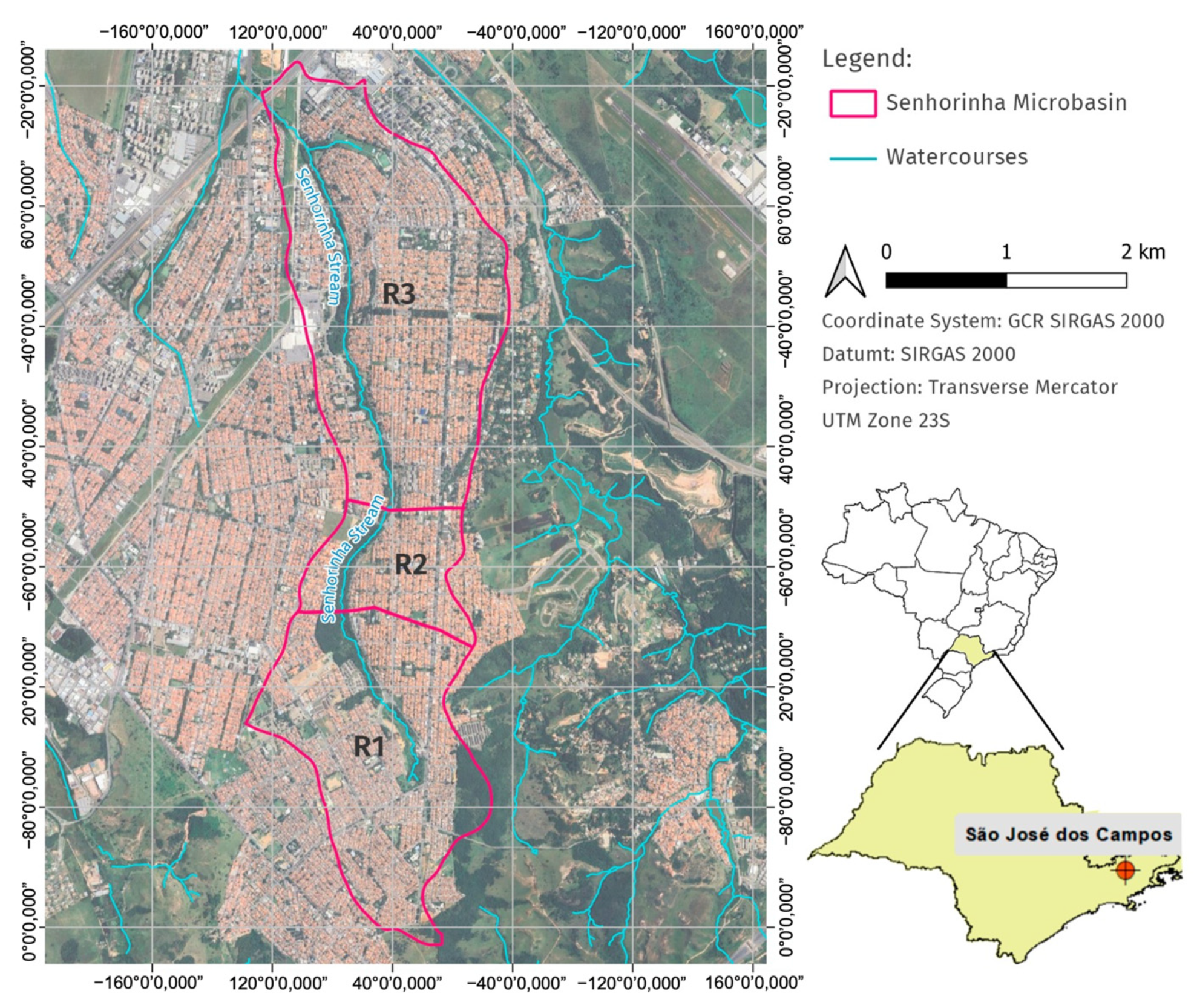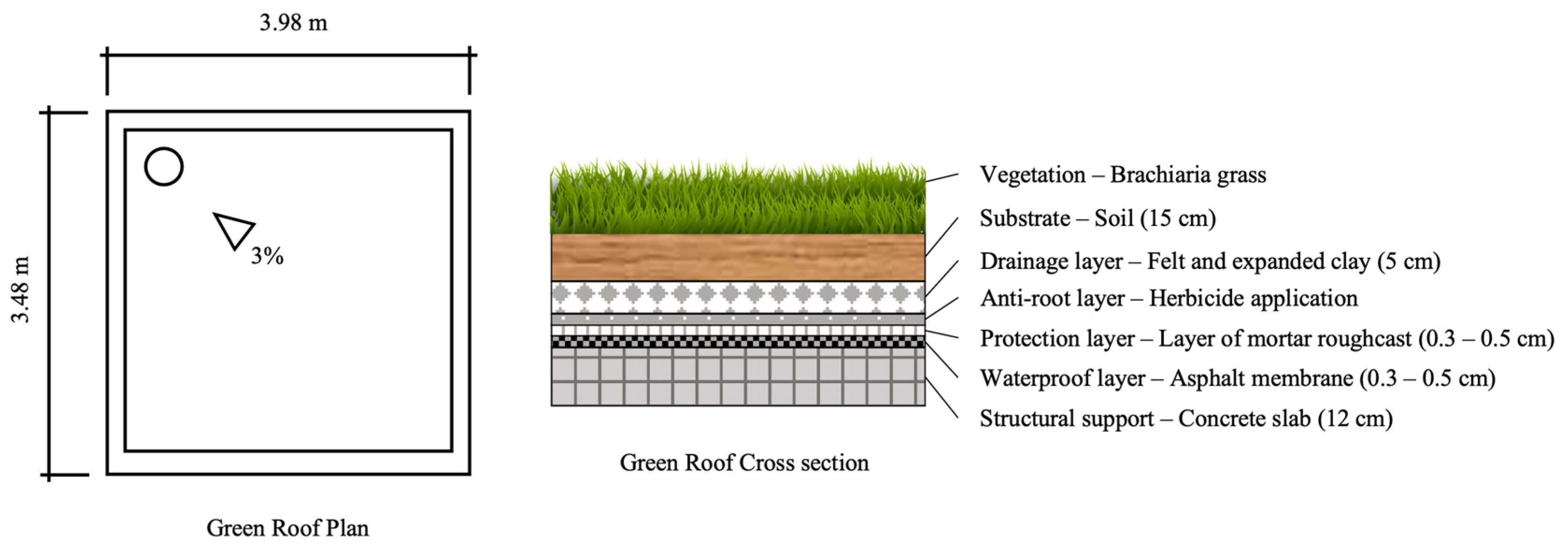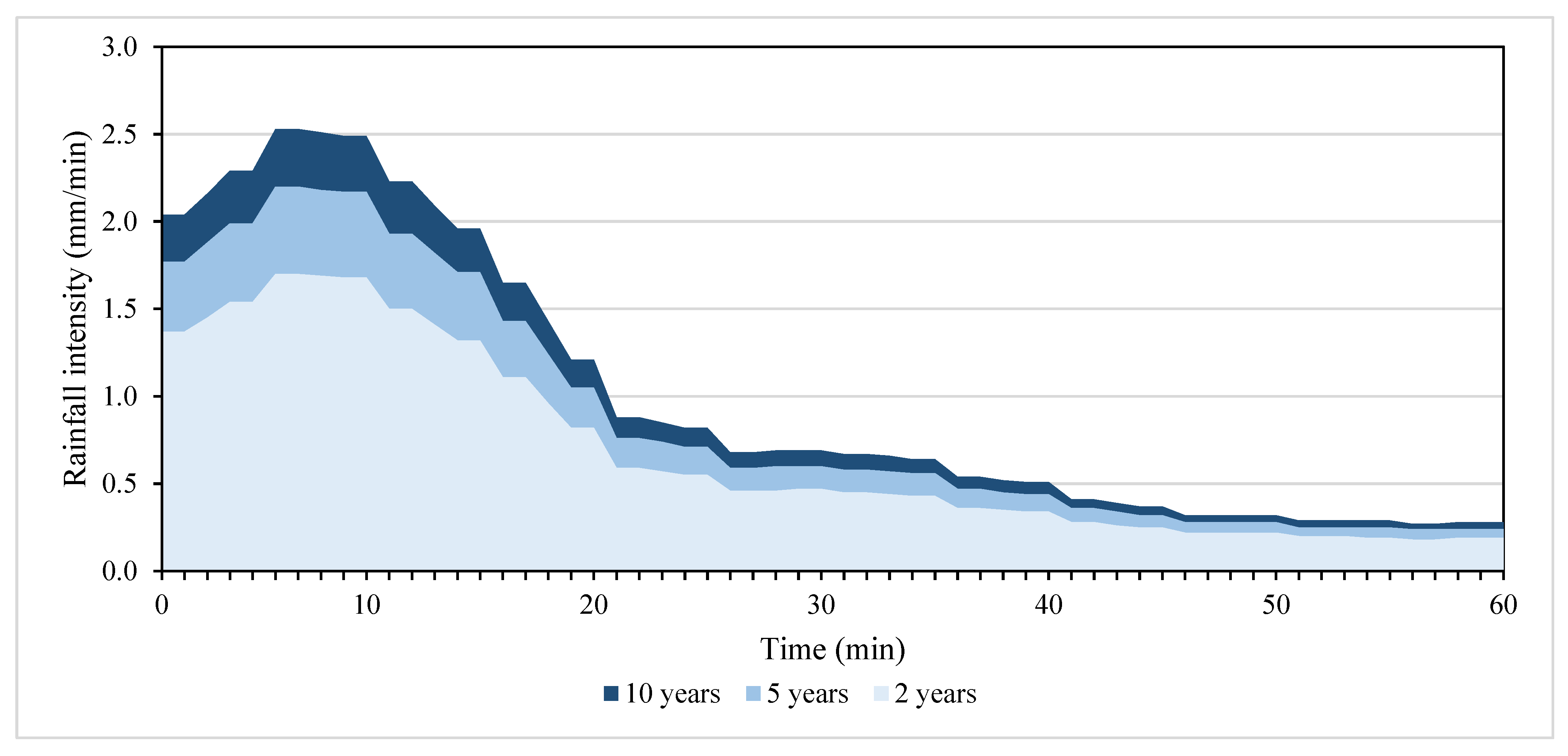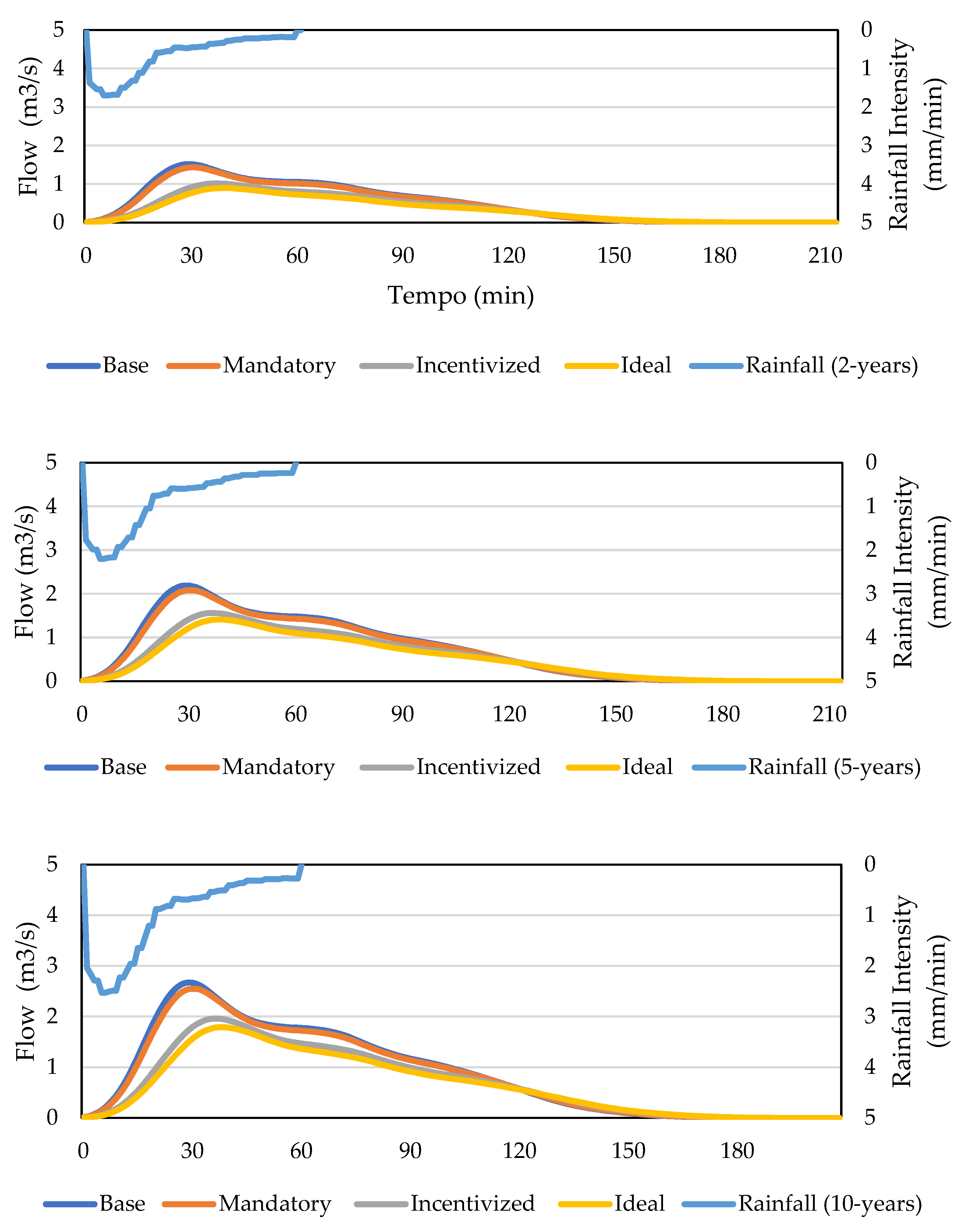Hydrological Benefits of Green Roof Retrofitting Policies: A Case Study of an Urban Watershed in Brazil
Abstract
1. Introduction
2. Materials and Methods
2.1. Study Site
2.2. Hydrological Modeling
2.3. Simulated Scenarios
3. Results
3.1. Effect of EIA Reduction
3.2. Effect of Return Period
3.3. Implications
3.4. Limitations
4. Conclusions
Author Contributions
Funding
Data Availability Statement
Acknowledgments
Conflicts of Interest
References
- Deopa, R.; Thakur, D.A.; Kumar, S.; Mohanty, M.P.; Asha, P. Discerning the Dynamics of Urbanization-Climate Change-Flood Risk Nexus in Densely Populated Urban Mega Cities: An Appraisal of Efficient Flood Management through Spatiotemporal and Geostatistical Rainfall Analysis and Hydrodynamic Modeling. Sci. Total Environ. 2024, 952, 175882. [Google Scholar] [CrossRef] [PubMed]
- Elliot, T.; Torres-Matallana, J.A.; Teebken, J. Urbanization under Extreme Climate Events Leads to Synchronized Decreases in Flood Protection and Increases in Vulnerability. Cities 2025, 160, 105827. [Google Scholar] [CrossRef]
- Seemuangngam, A.; Lin, H.L. The Impact of Urbanization on Urban Flood Risk of Nakhon Ratchasima, Thailand. Appl. Geogr. 2024, 162, 103152. [Google Scholar] [CrossRef]
- Obropta, C.C.; Del Monaco, N. Reducing Directly Connected Impervious Areas with Green Stormwater Infrastructure. J. Sustain. Water Built Environ. 2018, 4, 5017004. [Google Scholar] [CrossRef]
- Sohn, W.; Kim, J.H.; Li, M.H.; Brown, R.D.; Jaber, F.H. How Does Increasing Impervious Surfaces Affect Urban Flooding in Response to Climate Variability? Ecol. Indic. 2020, 118, 106774. [Google Scholar] [CrossRef]
- Zhou, H.; Luan, Q.; Gao, C.; Lu, Z.; Liu, J. An Approach for Identifying Key Factors Controlling Variable Source Impervious Area in Heterogeneous Urban Landscapes under the Influence of Overland Flow Path. J. Hydrol. 2025, 655, 132915. [Google Scholar] [CrossRef]
- Sciuto, L.; Licciardello, F.; Scavera, V.; Verde, D.; Giuffrida, E.R.; Cirelli, G.L. The Role of Nature-Based Solutions for the Water Flow Management in a Mediterranean Urban Area. Ecol. Eng. 2024, 208, 107375. [Google Scholar] [CrossRef]
- Gholamnia, M.; Sajadi, P.; Khan, S.; Sannigrahi, S.; Ghaffarian, S.; Shahabi, H.; Pilla, F. Assessment and Modeling of Green Roof System Hydrological Effectiveness in Runoff Control: A Case Study in Dublin. IEEE Access 2024, 12, 189689–189709. [Google Scholar] [CrossRef]
- Pace, R.; Endreny, T.A.; Ciolfi, M.; Gangwisch, M.; Saha, S.; Ruehr, N.K.; Grote, R. Mitigation Potential of Urban Greening during Heatwaves and Stormwater Events: A Modeling Study for Karlsruhe, Germany. Sci. Rep. 2025, 15, 5308. [Google Scholar] [CrossRef]
- Koohestani, S.S.; Mukheibir, P.; Wakefield-Ran, R.; Santamouris, M. Adopting a Socio-Technical Perspective on the Challenges and Barriers in Transitioning to Blue-Green Infrastructure (BGI). Blue-Green Syst. 2025, 7, 79–94. [Google Scholar] [CrossRef]
- Chen, S.; Gou, Z. An Investigation of Green Roof Spatial Distribution and Incentive Policies Using Green Buildings as a Benchmark. Land 2022, 11, 2067. [Google Scholar] [CrossRef]
- Wang, J.; Mukhopadhyaya, P.; Valeo, C. Implementing Green Roofs in the Private Realm for City-Wide Stormwater Management in Vancouver: Lessons Learned from Toronto and Portland. Environments 2023, 10, 102. [Google Scholar] [CrossRef]
- Liberalesso, T.; Oliveira Cruz, C.; Matos Silva, C.; Manso, M. Green Infrastructure and Public Policies: An International Review of Green Roofs and Green Walls Incentives. Land Use Policy 2020, 96, 104693. [Google Scholar] [CrossRef]
- IPPLAN. Avaliação de Áreas de Risco Do Município de São José Dos Campos. Available online: https://www.sjc.sp.gov.br/media/45004/pmrr_final_i_e_ii.pdf (accessed on 18 June 2025).
- Marques, T.H.N.; Rizzi, D.; Ferraz, V.; Herzog, C.P. Soluções Baseadas Na Natureza: Conceituação, Aplicabilidade e Complexidade No Contexto Latino-Americano, Casos Do Brasil e Peru. Rev. Labverde 2021, 11, 12–49. [Google Scholar] [CrossRef]
- Borges, C.B.N.; Amorim, L.; Gonzaga, S.C.M.; Nogueira, F.F.; Silva, F.G.; Martins, J.R.S.; Itajahy, D.; Venturi, S.G.; Chaves, C.F. Critério Para a Escolha de Anteprojeto de Técnicas de Drenagem Sustentável—Estudo de Caso Córrego Senhorinha em São José Dos Campos. In Proceedings of the XV Encontro Nacional de Águas Urbanas, Recife, Brazil, 16–20 September 2024; ABRHidro: Recife, Brazil, 2024; p. 10. [Google Scholar]
- Rossi, M. Mapa Pedológico do Estado de São Paulo: Revisado e Ampliado; Instituto Florestal: São Paulo, Brazil, 2017; ISBN 3239660180. [Google Scholar]
- Sartori, A.; Neto, F.; Genovez, A. Classificação Hidrológica de Solos Brasileiros para a Estimativa da Chuva Excedente com o Método do Serviço de Conservação do Solo dos Estados Unidos Parte 1: Classificação. Rev. Bras. Recur. Hídricos 2005, 10, 5–18. [Google Scholar] [CrossRef]
- Soil Conservation Service (SCS). Estimation of Direct Runoff from Storm Rainfall. In National Engineering Handbook; U.S. Department of Agriculture: Washington, DC, USA, 1956. [Google Scholar]
- USDA. Estimating Runoff Volume and Peak Discharge. In National Engineering Handbook; USDA Natural Resources Conservation Service: Washington, DC, USA, 2021. [Google Scholar]
- Amorim, L.F.; Magalhães, A.A.B.; Martins, J.R.S.; Duarte, B.P.D.S.; Nogueira, F.F. Hydrological Modeling Using Distributed Rainfall Data to Represent the Flow in Urban Watersheds. Rev. Bras. Recur. Hidricos 2022, 27, e30. [Google Scholar] [CrossRef]
- Prefeitura do Município de São José dos Campos. Produto 1: Relatório Técnico de Manejo Sustentável e Controle Da Poluição Difusa. In Estudo para Desenvolvimento de Tecnologias Aplciadas à Drenagem Sustenável para o Município de São José dos Campos; Prefeitura do Município de São José dos Campos: São José dos Campos, Brazil, 2024. [Google Scholar]
- Pereira-Flores, M.E.; Justino, F.; Rodrigues, J.M.; Boehringer, D.; Melo, A.A.M.; Cursi, A.G.; da Costa Pereira, V.; Pereira, O.G.; Ruiz-Vera, U.M. Seasonal Climate Impact on Brazilian Pasture (Brachiaria Brizantha Cv Marandu): Growth Rate, CO2 Efflux, and Irrigation Strategies. Theor. Appl. Climatol. 2023, 151, 651–666. [Google Scholar] [CrossRef]
- Tassi, R.; Lorenzini, F.; Allasia, D.G. Tool to Address Green Roof Widespread Implementation Effect in Flood Characteristics for Water Management Planning. IAHS-AISH Proc. Rep. 2015, 370, 217–222. [Google Scholar] [CrossRef]
- Departamento de Águas e Energia Elétrica (DAEE). Precipitações Intensas No Estado de São Paulo; DAEE/CTH: Sao Paulo, Brazil, 2018. [Google Scholar]
- Prefeitura do Município de São José dos Campos. Etapa 1—Drenagem Urbana. In Plano Diretor de Drenagem e Manejo de Águas Pluviais; Prefeitura do Município de São José dos Campos: São José dos Campos, Brazil, 2021; p. 158. [Google Scholar]
- Palla, A.; Gnecco, I. Hydrologic Modeling of Low Impact Development Systems at the Urban Catchment Scale. J. Hydrol. 2015, 528, 361–368. [Google Scholar] [CrossRef]
- Kleidorfer, M.; Mikovits, C.; Jasper-Tönnies, A.; Huttenlau, M.; Einfalt, T.; Rauch, W. Impact of a Changing Environment on Drainage System Performance. Procedia Eng. 2014, 70, 943–950. [Google Scholar] [CrossRef][Green Version]
- Orsi, E.; Crispino, G.; Iervolino, M.; Gisonni, C. Hydraulic and Hydrologic Invariance: Effectiveness of Green Roofs and Permeable Pavements. J. Irrig. Drain. Eng. 2025, 151, 04025001. [Google Scholar] [CrossRef]
- Sims, A.W.; Robinson, C.E.; Smart, C.C.; O’Carroll, D.M. Mechanisms Controlling Green Roof Peak Flow Rate Attenuation. J. Hydrol. 2019, 577, 123972. [Google Scholar] [CrossRef]
- Bengtsson, L. Peak Flows from Thin Sedum-Moss Roof. Nord. Hydrol. 2005, 36, 269–280. [Google Scholar] [CrossRef]
- Cavadini, G.B.; Rodriguez, M.; Cook, L.M. Connecting Blue-Green Infrastructure Elements to Reduce Combined Sewer Overflows. J. Environ. Manag. 2024, 365, 121465. [Google Scholar] [CrossRef]
- Vijayaraghavan, K.; Biswal, B.K.; Adam, M.G.; Soh, S.H.; Tsen-Tieng, D.L.; Davis, A.P.; Chew, S.H.; Tan, P.Y.; Babovic, V.; Balasubramanian, R. Bioretention Systems for Stormwater Management: Recent Advances and Future Prospects. J. Environ. Manag. 2021, 292, 112766. [Google Scholar] [CrossRef]
- Osawa, T.M.; Cristina, M.; Pereira, S.; Chaves, B.; Leite, C.; Rodolfo, J.; Martins, S. Impact of an Aged Green Roof on Stormwater Quality and First-Flush Dynamics. Buildings 2025, 15, 1763. [Google Scholar] [CrossRef]
- Rahman, M.A.; Alim, M.A.; Jahan, S.; Rahman, A. Vegetated Roofs as a Means of Sustainable Urban Development: A Scoping Review. Water 2022, 14, 3188. [Google Scholar] [CrossRef]
- Meng, F.; Yuan, Q.; Bellezoni, R.A.; Puppim de Oliveira, J.A.; Hu, Y.; Jing, R.; Liu, G.; Yang, Z.; Seto, K.C. The Food-Water-Energy Nexus and Green Roofs in Sao Jose Dos Campos, Brazil, and Johannesburg, South Africa. NPJ Urban Sustain. 2023, 3, 12. [Google Scholar] [CrossRef]
- Liberalesso, T.; Silva, C.M.; Cruz, C.O. Combined Strategies for Green Roof Incentive Policies in Lisbon: Evaluating the Potentiality of Concession Grants and Identifying Priority Intervention Areas. Urban For. Urban Green. 2024, 99, 128451. [Google Scholar] [CrossRef]
- Jayasooriya, V.; Fernando, S.; Silva, C.; Muthukumaran, S. Comparative Analysis on the Effectiveness of Green Roofs and Photovoltaic Panels as Sustainable Rooftop Technologies. Environ. Sci. Pollut. Res. 2023, 30, 98977–98992. [Google Scholar] [CrossRef]
- Mendonça, R.; Roebeling, P.; Fidélis, T.; Saraiva, M. Can Policy Instruments Enhance the Benefits of Nature-Based Solutions and Curb Green Gentrification? The Case of Genova, Italy. Environ. Dev. 2024, 50, 100995. [Google Scholar] [CrossRef]
- Ferreira, V.d.N.; De Araujo, L.O.C.; Qualharini, E.L.; Vazquez, E.G.; Chaer, I.; Najjar, M.K. Building Retrofit for Energy Efficiency in Existing Buildings: A Case Study of a Social Residential Building in France. DYSONA—Appl. Sci. 2025, 6, 223–238. [Google Scholar] [CrossRef]
- Khalaji, F.; Zhang, J.; Sharma, A.K. Social and Economic Impacts of Water Sensitive Urban Design: A Review. Water 2025, 17, 16. [Google Scholar] [CrossRef]
- Treglia, M.L.; McPhearson, T.; Sanderson, E.W.; Yetman, G.; Maxwell, E.N. Examining the Distribution of Green Roofs in New York City through a Lens of Social, Ecological, and Technological Filters. Ecol. Soc. 2022, 27, 20. [Google Scholar] [CrossRef]
- Wu, J.; Yang, P.; Yi, K.; Zhou, Y.; Tan, Q. Residents’ Heterogeneous Willingness to Adopt Green Roofs in a Southern Chinese City Revealed via Interpretable Machine Learning. Ecol. Indic. 2025, 171, 113237. [Google Scholar] [CrossRef]
- Hamouz, V.; Møller-Pedersen, P.; Muthanna, T.M. Modelling Runoff Reduction through Implementation of Green and Grey Roofs in Urban Catchments Using PCSWMM. Urban Water J. 2020, 17, 813–826. [Google Scholar] [CrossRef]
- Yao, L.; Wu, Z.; Wang, Y.; Sun, S.; Wei, W.; Xu, Y. Does the Spatial Location of Green Roofs Affects Runoff Mitigation in Small Urbanized Catchments? J. Environ. Manag. 2020, 268, 110707. [Google Scholar] [CrossRef]
- Palla, A.; Gnecco, I.; La Barbera, P. Assessing the Hydrologic Performance of a Green Roof Retrofitting Scenario for a Small Urban Catchment. Water 2018, 10, 1052. [Google Scholar] [CrossRef]







| LULC | Area (m2) | Percentage (%) |
|---|---|---|
| Residential | 3,876,433 | 40.4% |
| Roads | 2,173,534 | 22.7% |
| Green areas | 1,715,220 | 17.9% |
| Commerce and service | 618,232 | 6.4% |
| Others | 1,090,643 | 7.8% |
| Total area | 9,595,869 | 100% |
| LULC Classification | SCS-CN Land Use Category | CN (Soil Group B) |
|---|---|---|
| Cemetery | Open space in poor condition | 79 |
| Commerce and Services | Commercial and business | 92 |
| Industrial | Industrial | 88 |
| Horizontal Residential | Residential Type I | 85 |
| Vertical Residential | Residential Type I | 85 |
| Gated Communities | Residential Type II | 75 |
| Residential Green Areas | Open space in fair condition | 69 |
| Green Area (Park, PMSJC) | Open space in good condition | 61 |
| Parking | Paved roads with drainage | 98 |
| Institutional | Residential Type I | 85 |
| Mixed-use | Residential Type I | 85 |
| Utility Area | Residential Type I | 85 |
| Vacant Land | Natural desert landscaping | 77 |
| Roadside Vegetation | Open space in fair condition | 69 |
| Roads | Paved roads with drainage | 98 |
| Rural Residential | Residential Type III | 72 |
| Informal Settlements | Developing urban area | 86 |
| Sub-Basin | Area () | Channel Length (km) | River Slope | IA (%) | EIA | CN | Tc (h) |
|---|---|---|---|---|---|---|---|
| R1 | 3.37 | 1.54 | 1.6% | 51% | 35% | 89.2 | 0.182 |
| R2 | 1.08 | 1.00 | 0.9% | 48% | 34% | 87.9 | 0.160 |
| R3 | 4.79 | 3.54 | 0.3% | 55% | 38% | 90.5 | 0.655 |
| Event Number | RMSE | NSE |
|---|---|---|
| 1 | 1.18 | 0.97 |
| 2 | 0.93 | 0.73 |
| 3 | 3.06 | 0.07 |
| 4 | 0.57 | 0.87 |
| 5 | 1.25 | 0.83 |
| 6 | 0.33 | 0.63 |
| 7 | 0.11 | 0.87 |
| 8 | 0.73 | 0.31 |
| Scenarios | IA and EIA Retrofitted to Green Roof (%) | ||||
|---|---|---|---|---|---|
| Residential | Commerce and Service | Others | Green Areas | Road | |
| Base | - | - | - | - | - |
| Mandatory | 10% | 10% | 10% | - | - |
| Incentivized | 80% | 10% | 10% | - | - |
| Ideal | 80% | 80% | 80% | - | - |
| Scenarios | GR Area () | GR Area | IA | EIA | Time of Concentration (h) | CN | ||||
|---|---|---|---|---|---|---|---|---|---|---|
| R1 | R2 | R3 | R1 | R2 | R3 | |||||
| Base | 0.00 | 0% | 53% | 37% | 0.182 | 0.160 | 0.655 | 89.2 | 88.0 | 90.5 |
| Mandatory | 0.34 | 4% | 49% | 34% | 0.188 | 0.168 | 0.663 | 88.6 | 87.1 | 89.8 |
| Incentivized | 2.09 | 23% | 30% | 21% | 0.223 | 0.207 | 0.700 | 85.2 | 83.3 | 89.7 |
| Ideal | 2.74 | 30% | 23% | 16% | 0.231 | 0.221 | 0.718 | 84.3 | 82.0 | 89.7 |
| Hydrological Performance | Scenarios | ||
|---|---|---|---|
| Mandatory (EIA = 34%) | Incentivized (EIA = 21%) | Ideal (EIA = 16%) | |
| Two-year return period | |||
| Peak attenuation (%) | 6% | 33% | 41% |
| Peak delay (%) | 3% | 27% | 33% |
| Centroid delay (%) | 1% | 10% | 13% |
| Runoff volume reduction (%) | 4% | 26% | 35% |
| Five-year return period | |||
| Peak attenuation (%) | 5% | 29% | 36% |
| Peak delay (%) | 3% | 27% | 33% |
| Centroid delay (%) | 1% | 10% | 12% |
| Runoff volume reduction (%) | 4% | 22% | 29% |
| Ten-year return period | |||
| Peak attenuation (%) | 5% | 27% | 33% |
| Peak delay (%) | 3% | 27% | 30% |
| Centroid delay (%) | 1% | 10% | 12% |
| Runoff volume reduction (%) | 3% | 20% | 26% |
Disclaimer/Publisher’s Note: The statements, opinions and data contained in all publications are solely those of the individual author(s) and contributor(s) and not of MDPI and/or the editor(s). MDPI and/or the editor(s) disclaim responsibility for any injury to people or property resulting from any ideas, methods, instructions or products referred to in the content. |
© 2025 by the authors. Licensee MDPI, Basel, Switzerland. This article is an open access article distributed under the terms and conditions of the Creative Commons Attribution (CC BY) license (https://creativecommons.org/licenses/by/4.0/).
Share and Cite
Osawa, T.M.; Nogueira, F.F.; Gonzaga, S.C.M.; Silva, F.G.; Miranda, S.D.; Leite, B.C.C.; Martins, J.R.S. Hydrological Benefits of Green Roof Retrofitting Policies: A Case Study of an Urban Watershed in Brazil. Water 2025, 17, 1936. https://doi.org/10.3390/w17131936
Osawa TM, Nogueira FF, Gonzaga SCM, Silva FG, Miranda SD, Leite BCC, Martins JRS. Hydrological Benefits of Green Roof Retrofitting Policies: A Case Study of an Urban Watershed in Brazil. Water. 2025; 17(13):1936. https://doi.org/10.3390/w17131936
Chicago/Turabian StyleOsawa, Thiago Masaharu, Fábio Ferreira Nogueira, Stephanie Caroline Machado Gonzaga, Fernando Garcia Silva, Sabrina Domingues Miranda, Brenda Chaves Coelho Leite, and José Rodolfo Scarati Martins. 2025. "Hydrological Benefits of Green Roof Retrofitting Policies: A Case Study of an Urban Watershed in Brazil" Water 17, no. 13: 1936. https://doi.org/10.3390/w17131936
APA StyleOsawa, T. M., Nogueira, F. F., Gonzaga, S. C. M., Silva, F. G., Miranda, S. D., Leite, B. C. C., & Martins, J. R. S. (2025). Hydrological Benefits of Green Roof Retrofitting Policies: A Case Study of an Urban Watershed in Brazil. Water, 17(13), 1936. https://doi.org/10.3390/w17131936







